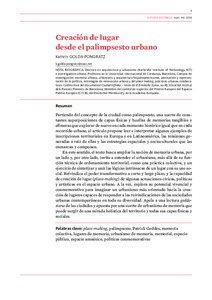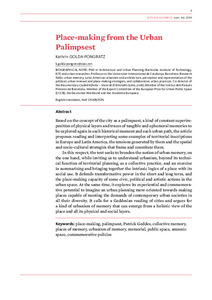| dc.contributor.author | Golda-Pongratz, Kathrin | |
| dc.date.accessioned | 2021-01-29T10:18:27Z | |
| dc.date.available | 2021-01-29T10:18:27Z | |
| dc.date.issued | 2019 | |
| dc.identifier.issn | 2385-362X | |
| dc.identifier.issn | 0212-3819 | |
| dc.identifier.uri | http://hdl.handle.net/20.500.11904/1186 | |
| dc.description.abstract | <p>Based on the concept of the city as a palimpsest, a kind of constant superimposition of physical layers and traces of tangible and ephemeral memories to be explored again in each historical moment and each urban path, the article proposes reading and interpreting some examples of territorial inscriptions in Europe and Latin America, the tensions generated by them and the spatial and socio-cultural strategies that frame and constitute them.</p>
<p>In this respect, the text seeks to broaden the notion of urban memory, on the one hand, while inviting us to understand urbanism, beyond its technical function of territorial planning, as a collective practice, and an exercise in summarising and bringing together the intrinsic logics of a place with its social use. It defends transformative power in the short and long term, and the place-making capacity of some civic, political and artistic actions in the urban space. At the same time, it explores its experiential and commemorative potential to imagine an urban planning more oriented towards making places capable of meeting the demands of contemporary urban societies in all their diversity. It calls for a Geddesian reading of cities and argues for a kind of urbanism of memory that can emerge from a holistic view of the place and all its physical and social layers.</p> | |
| dc.description.abstract | <div id="articleAbstract">
<div>
<p>Partiendo del concepto de la ciudad como palimpsesto, una suerte de constantes superposiciones de capas físicas y huellas de memorias tangibles y efímeras que explorar de nuevo en cada momento histórico igual que en cada recorrido urbano, el artículo propone leer e interpretar algunos ejemplos de inscripciones territoriales en Europa y en Latinoamérica, las tensiones generadas a raíz de ellas y las estrategias espaciales y socioculturales que las enmarcan y componen.</p>
<p>En este sentido, el texto busca ampliar la noción de memoria urbana, por un lado y, por otro lado, invita a entender el urbanismo, más allá de su función técnica de ordenamiento territorial, como una práctica colectiva, y un ejercicio de sintetizar y unir las lógicas intrínsecas de un lugar con su uso social. Reivindica el poder transformativo a corto y largo plazo, y la capacidad de creación de lugar (place-making) de algunas actuaciones cívicas, políticas y artísticas en el espacio urbano. A la vez, explora su potencial vivencial y conmemorativo para imaginar un urbanismo más orientado hacia la creación de lugares capaces de responder a las reivindicaciones de las sociedades urbanas contemporáneas en toda su diversidad. Apela a una lectura geddesiana de las ciudades y apuesta por una suerte de urbanismo de memoria que puede surgir de una mirada holística del territorio y todas sus capas físicas y sociales.</p>
</div>
</div> | |
| dc.relation.ispartof | Estudis escènics: quaderns de l'Institut del Teatre. 2019, Núm. 44 | |
| dc.title | Place-making from the Urban Palimpsest | |
| dc.type | Article | |
| dc.date.updated | 2021-01-29T10:18:29Z | |
| dc.rights.access | Open Access | |



